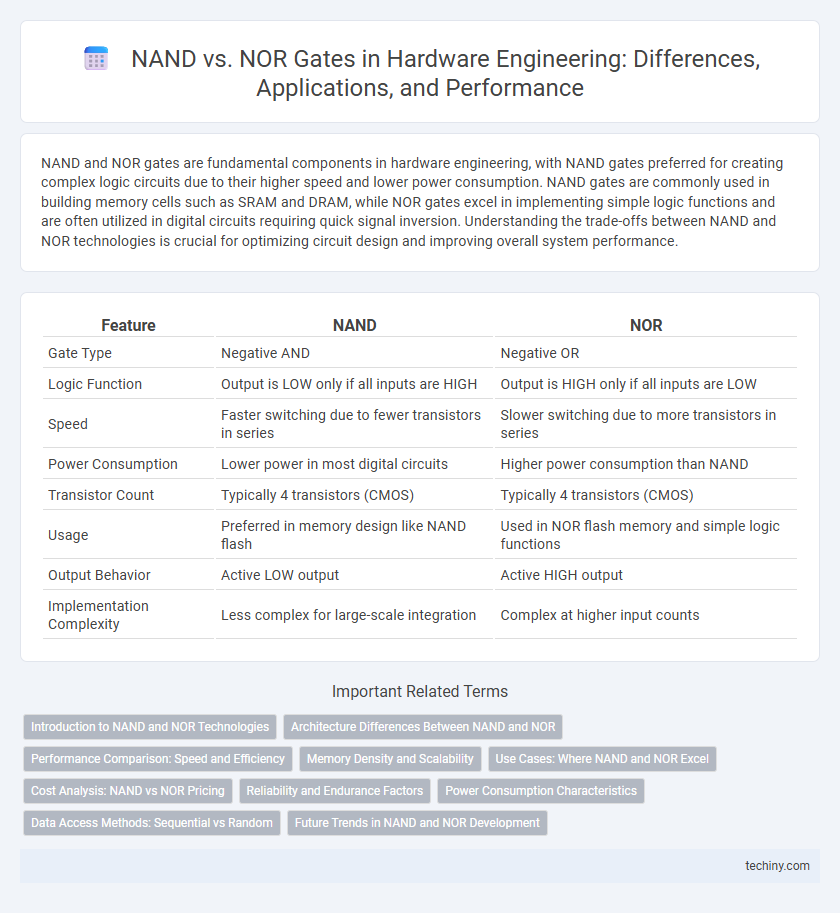NAND and NOR gates are fundamental components in hardware engineering, with NAND gates preferred for creating complex logic circuits due to their higher speed and lower power consumption. NAND gates are commonly used in building memory cells such as SRAM and DRAM, while NOR gates excel in implementing simple logic functions and are often utilized in digital circuits requiring quick signal inversion. Understanding the trade-offs between NAND and NOR technologies is crucial for optimizing circuit design and improving overall system performance.
Table of Comparison
| Feature | NAND | NOR |
|---|---|---|
| Gate Type | Negative AND | Negative OR |
| Logic Function | Output is LOW only if all inputs are HIGH | Output is HIGH only if all inputs are LOW |
| Speed | Faster switching due to fewer transistors in series | Slower switching due to more transistors in series |
| Power Consumption | Lower power in most digital circuits | Higher power consumption than NAND |
| Transistor Count | Typically 4 transistors (CMOS) | Typically 4 transistors (CMOS) |
| Usage | Preferred in memory design like NAND flash | Used in NOR flash memory and simple logic functions |
| Output Behavior | Active LOW output | Active HIGH output |
| Implementation Complexity | Less complex for large-scale integration | Complex at higher input counts |
Introduction to NAND and NOR Technologies
NAND and NOR technologies represent fundamental types of flash memory used in hardware engineering, each with unique architectures. NAND flash is organized in a series of memory cells, offering higher density and faster write and erase speeds, making it ideal for mass storage applications. NOR flash provides faster random access times and greater reliability for code execution, commonly utilized in embedded systems requiring fast read operations.
Architecture Differences Between NAND and NOR
NAND and NOR flash memory differ significantly in architecture, impacting speed, density, and reliability. NAND architecture connects memory cells in series, enabling higher density and faster write/erase speeds, making it ideal for data storage applications. NOR architecture arranges memory cells in parallel, providing faster read speeds and allowing random access, which is essential for code execution in embedded systems.
Performance Comparison: Speed and Efficiency
NAND flash memory offers faster write and erase speeds compared to NOR flash due to its architecture that allows multi-bit storage per cell, enhancing overall efficiency in data-intensive applications. NOR flash provides quicker read times, making it ideal for execute-in-place (XIP) scenarios where fast random access is critical. The choice between NAND and NOR hinges on application requirements, balancing NAND's superior write speed and density with NOR's low-latency read capabilities.
Memory Density and Scalability
NAND flash memory offers higher memory density compared to NOR due to its compact cell structure, enabling more data storage per unit area. NAND scalability benefits from smaller transistor sizes and efficient cell arrangements, making it ideal for high-capacity applications like SSDs. NOR flash provides faster read speeds but at the cost of lower density and limited scalability in advanced process nodes.
Use Cases: Where NAND and NOR Excel
NAND flash memory excels in high-density data storage applications such as solid-state drives (SSDs) and USB drives due to its cost-effectiveness and faster write speeds. NOR flash is preferred in embedded systems and microcontrollers where fast random read access and execute-in-place (XIP) capabilities are critical for firmware storage. The choice between NAND and NOR depends on balancing factors like speed, endurance, density, and cost based on the specific hardware engineering requirements.
Cost Analysis: NAND vs NOR Pricing
NAND flash memory generally offers lower cost per bit compared to NOR due to its higher density and simpler cell architecture, making it suitable for mass storage applications. NOR flash, while more expensive per bit, provides faster read speeds and greater reliability in code execution, justifying its use in embedded systems with critical boot code. Cost analysis reveals NAND's pricing advantage primarily stems from economies of scale and manufacturing efficiency in high-volume production.
Reliability and Endurance Factors
NAND flash memory offers higher storage density and faster write speeds but generally has lower reliability and endurance compared to NOR flash, which provides superior read stability and longer write-erase cycles. NOR flash exhibits better data retention and is less susceptible to program/erase cycle degradation, making it ideal for code execution in embedded systems requiring high reliability. Endurance in NAND is typically measured in thousands of cycles, whereas NOR endures tens of thousands, significantly impacting lifecycle expectations in hardware engineering applications.
Power Consumption Characteristics
NAND flash memory exhibits lower power consumption during write and erase operations compared to NOR flash, making it ideal for energy-efficient storage solutions. NOR flash, while consuming more power due to its parallel architecture, offers faster read speeds and is typically used in applications requiring quick code execution. Power management in hardware design must consider NAND's superior energy efficiency for extended battery life in portable devices.
Data Access Methods: Sequential vs Random
NAND flash memory utilizes sequential data access methods, optimizing write and erase cycles for large blocks, which accelerates bulk data storage applications and increases endurance. NOR flash supports random data access, enabling fast and precise byte-level read operations ideal for code execution and frequent direct reads. Choosing between NAND and NOR depends on the need for high-speed sequential writes versus low-latency random reads in hardware engineering designs.
Future Trends in NAND and NOR Development
Emerging trends in NAND development emphasize increasing storage density through 3D stacking technologies, enabling higher capacity and faster performance for solid-state drives. NOR flash memory advancements focus on enhancing read speeds and reliability, targeting applications in IoT devices and automotive systems where fast code execution and endurance are critical. Both NAND and NOR technologies are integrating advanced error correction and low-power design techniques to meet the growing demands of artificial intelligence and edge computing environments.
NAND vs NOR Infographic

 techiny.com
techiny.com